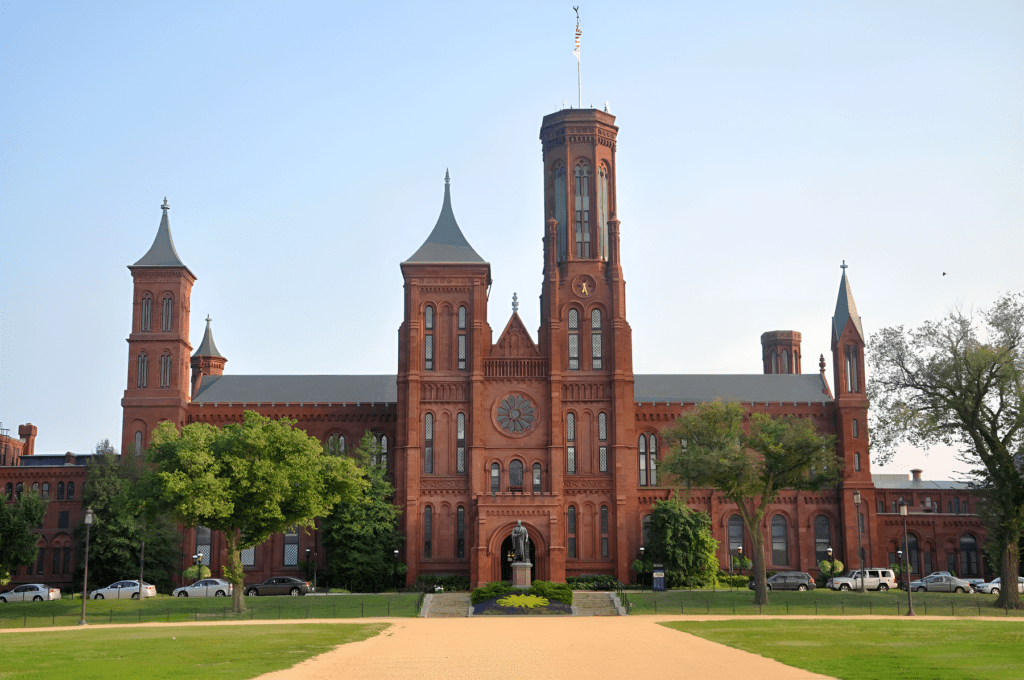The Smithsonian Institution, or “the nation’s attic,” stores some of the most extraordinary items of American history. The Institution, located in Washington, D.C., includes 21 museums and galleries,14 education and research centers, and the National Zoo. Millions of exhibits on science, history, art, and culture are freely accessible to everyone in the Smithsonian.
History of the Smithsonian Institution
In 1846, British scientist James Smithson created the Smithsonian Institution with his fortune. Smithson left a sizable sum of money “to the United States of America, to found, at Washington, an institution for the increase and diffusion of knowledge among men.” Despite never visiting the United States, Smithson’s unknown benefaction now covers multiple fields and remains one of the most visited collections in the world. In 1855, they built the Institution’s first skyscraper, the Smithsonian Castle, and it has remained open since then. Smithsonians’ network eventually expanded to include many specialized museums, each dedicated to a separate field.
Museum Structure and Collections
The museums are primarily situated along the National Mall in Washington, D.C. Here are some examples of them: the National Museum of American History, the National Museum of Natural History, the National Air and Space Museum, and the Smithsonian American Art Museum. Each museum focuses on a specific area and explores various aspects of American and international heritage. For instance, the National Museum of American History represents U.S. social, political, and scientific evolution. Among the items on display are the Star-Spangled Banner and First Ladies’ Inaugural Gowns. At the same time, the National Museum of Natural History exhibits millions of natural artifacts. It includes, among other things, the Hope Diamond and the Evolution Exhibit.
With 21 museums, multiple research centers, and more than 137 million objects in its collections, from the original Wright Flyer to the Hope Diamond to Graham Bell’s telephone, it is home to unimaginable treasures exploring arts, culture, sciences, and humanities. The Institution’s museums are free of charge to visit, with the exception of the Cooper Hewitt Smithsonian Design Museum.
Funding and Governance
The Smithsonian is a trust, an unusual brand of public-private partnership. Federal dollars account for about two-thirds of its budget, and it also receives money from endowments, private contributions, and grants. Its $5 billion+ endowment sustains broad outreach, research, and programming efforts.
Research and Global Impact
While it is known mainly for its museums, the Smithsonian Institution has diverse research interests. It includes programs in environmental science, anthropology, and astrophysics, with research centers ranging from the Smithsonian Environmental Research Center to the Smithsonian Astrophysical Observatory. The centers help the Institution make critical contributions in areas such as biodiversity, climate change, and understanding cultures through global discovery.
Opening and Closing Times
Many of the Smithsonian are open daily from 10:00 a.m. Many of them have longer hours as per the demand during seasons or a specific event. All of the Smithsonian museums are closed on December 25 (Christmas Day). Like with most museums, correct hours are necessary to check on individual museums schedules, this especially can be very critical in the case of renovations or special exhibitions.
Smithsonian Museums — Must-See Exhibits
National Air and Space Museum: The museum exhibits the world’s most extensive collection of historic aircraft and spacecraft. Such as the Apollo 11 Command Module, the Wright brothers’ 1903 Flyer, and Charles Lindbergh’s “Spirit of St. Louis.” The museum is a mix of science, engineering, and historical fascination that grabs you right from the start.
National Museum of Natural History: Home to the Hope Diamond, as well as quite a few fossils, this museum is all about exploring nature. It includes dinosaur skeletons, and rare gems, along with displays on how life on earth has evolved. Sawgrass also features a ‘Butterfly Pavilion’ that lets you wander through live butterflies, bringing a bit of the outside indoors.
National Museum of American History: This history museum this a broad overview of culture and politics in the U.S. Highlights include the Star-Spangled Banner, Abraham Lincoln’s top hat, and items involving American innovation. The museum also delves into the nation’s musical history, from jazz to pop.
Smithsonian American Art Museum: One of the things they always say is that within subjectivity, there are many facts. The museum’s collection ranges from early colonial paintings to contemporary art. The collection features works by Georgia O’Keeffe and modern American photographers.
Latest News-From the Smithsonian
The Smithsonian keeps constantly innovating and upgrading its displays for the enjoyment of visitors. The National Air and Space Museum has undergone an extensive, multi-year renovation, resulting in the closure of certain sections until 2026, when new galleries are expected to open on a rolling basis.
More recently, the Smithsonian’s National Museum of African American History and Culture opened in 2016. Featuring a stirring display of African American history, culture, and civil rights heritage. It is still one of Washington, D.C.’s most significant landmarks.
The Smithsonian entered a partnership in 2024 with Amazon and NASA to digitize its extensive collection, enabling visitors around the globe to attend exhibits through augmented reality. This digital effort is designed to reach a wider audience and offer educational options outside of the museum itself.
Visiting Tips
Request also adhere to these recommendations concerning your vacation in all the Smithsonian. The Smithsonian is so vast that you can’t cover all of its offerings in a day anyway. If you’re planning a visit, it’s best to go on weekdays, as weekends, especially during the summer, can get crowded.
There are food options within the museums, but they are pricey, so you can bring something of your own or eat it before visiting the museums. You can always relax on the National Mall and enjoy some of that green space to go along with those museums.

